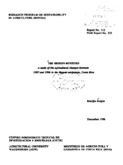| dc.contributor.author | Kuiper, M. | |
| dc.date.accessioned | 2014-10-20T05:43:15Z | |
| dc.date.available | 2014-10-20T05:43:15Z | |
| dc.date.issued | 1997 | es_ES |
| dc.identifier | 351863 | es_ES |
| dc.identifier.uri | https://repositorio.catie.ac.cr/handle/11554/5597 | |
| dc.description | 76 pág, 2 ilus, 56 tab, 17 ref. También como: Field Report - Atlantic Zone Programme (CATIE) no. 155 | es_ES |
| dc.description.abstract | The main focus of REPOSA is "development of an interdisciplinary methodology for the analysis and evaluation of ecologically and economically sustainable land use" (Jansen et al., 1996:1). The research is based on a combination of modeling, experimentation and multiple goal planning, resulting in alternative scenarios and thematic maps. In accordance with a micro-level, as well as regional focus of the program, target groups can be found at either level. At the small scale, beneficiaries are individual farmers, specialized entrepreneurs, extension services and farmer groups. At the (sub) regional level the target group consists of organizations involved in agricultural development. (Atlantic Zone Program, 1992). The present report is the result of a five month practical period for the Department of Development Economics (WAU), conducted within the scope of REPOSA. The study consists of a general analysis of the agriculture in the Neguev settlement and a comparison with the situation in 1987. After an exploratory survey in the Atlantic Zone three areas were selected for a general farm-survey, conducted in February 1987: the Neguev settlement, a western part of Río Jiménez and Las Lomas de Cocorí. Objectives of the survey were to obtain a general notion about the agricultural situation, probleMON and opinions of the producers providing a way for comparing different regions classifying farMON, to enable selections for more specific studies and finally providing a broad framework for more detailed studies. (Brink and Waaijenberg, 1990:1) Considering that almost a decade of intensive studies of the Neguev settlement has passed since, this framework might need to be revised to take into account changes which have occurred. Therefore, the primary objective of the study is obtaining a systematic insight into the present agricultural situation as well as the changes which have occurred during the 1987-1995 period in the Neguev settlement. A secondary objective of the study is obtaining additional data for my thesis directed at inclusion of land degradation in a multi-period linear programming model. General data on the presence and causes of land degradation and on the time-horizon of the farmers are gathered. Finally data regarding yield and input use per crop are gathered two important iteMON missing in the original 1987 survey. | es_ES |
| dc.language.iso | en | es_ES |
| dc.publisher | CATIE, Turrialba (Costa Rica). Atlantic Zone Programme Agricultural University Wageningen, Wageningen (Países Bajos) Ministerio de Agricultura y Ganadería, San José (Costa Rica) | es_ES |
| dc.relation.ispartof | Report - Atlantic Zone Programme | |
| dc.subject | SOSTENIBILIDAD | |
| dc.subject | SUELO | |
| dc.subject | UTILIZACION DE LA TIERRA | |
| dc.subject | CAMBIO TECNOLOGICO | |
| dc.subject | ADOPCION DE INNOVACIONES | |
| dc.subject | FERTILIDAD DEL SUELO | |
| dc.subject | DEGRADACION DEL SUELO | |
| dc.subject | CICLO BIOGEOQUIMICO | |
| dc.subject | ASENTAMIENTO RURALA | |
| dc.subject | ANALISIS DE COSTOS | |
| dc.subject | COSTOS DE PRODUCCION | |
| dc.subject | RENTABILIDAD | |
| dc.subject | CREDITO | |
| dc.subject | INSUMOS AGRICOLAS | |
| dc.subject | SISTEMAS DE EXPLOTACION | |
| dc.subject | AGROFORESTERIA | |
| dc.subject | PRODUCTOS AGRICOLAS | |
| dc.subject | CARACTERISTICAS DEL SITIO | |
| dc.subject | COSTA RICA | |
| dc.title | The Neguev revisited: a study of the agricultural changes between 1987 and 1996 in the Neguev settlement, Costa Rica | es_ES |
| dc.type | Tesis de maestría | es_ES |


